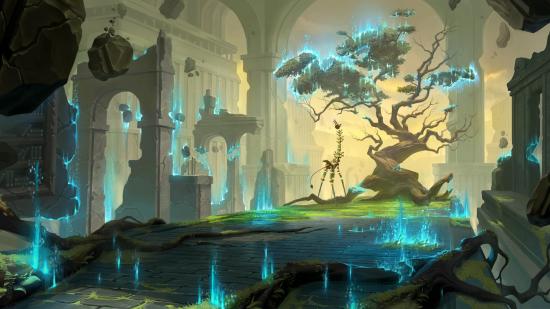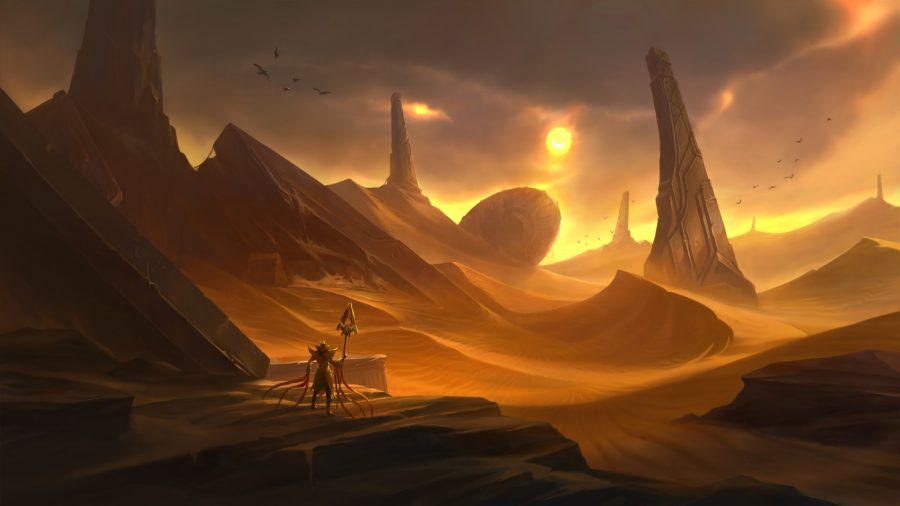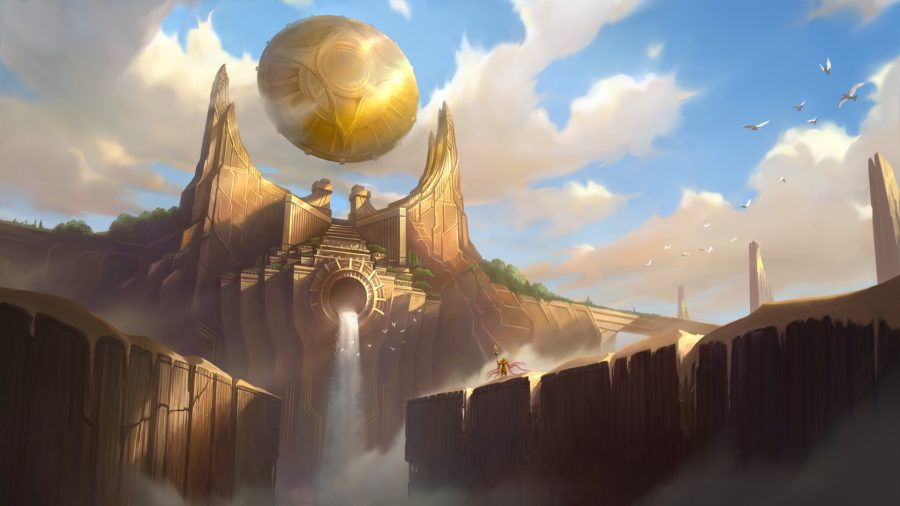Cards are a wonderful and varied element of world-building, and you can see it in so many different games. It could be Thronebreaker’s elaborate narrative scenarios, Meteorfall’s dungeons, or Griftlands using cards to represent items, reputation, and just about anything and everything. But, late last year, the card-battler Legends of Runeterra did something I haven’t seen before: it introduced landmark cards.
These playable buildings can’t block or attack, so they generally act as a supportive foundation for your followers, offering buffs and sometimes even win conditions. But while they play a humble role on the board, landmark cards have huge potential in regards to representing new regions. Before, Riot could only use champions and followers to characterise Runeterra’s diverse locations, but now it can literally build the world that they inhabit using cards.
It’s an idea that has really come to the fore in Legends of Runeterra’s newest expansion: Empires of the Ascended. Mark Sassenrath, the expansion’s design lead, and Mel Li, its narrative lead, kindly agreed to talk to us about landmark cards and building Empires of the Ascended.
Pocket Tactics: So Shurima is this ancient location filled with grand monuments and lost tombs. Did using landmark cards help you build that world in a way that regular cards couldn’t?
Mel Li: Absolutely! Shurima is a massive place that spans the entire southern continent. We were excited to get to represent a lot of these parts of the region that players had read about but have never seen before, from the gleaming Shuriman capital city and thriving city-states to vast desert expanses, to rocky cliffs, to lost tombs and monuments, and even the remains of fallen Icathia.
Landmarks that were susceptible to the ravages of time as shown by the Countdown mechanic reminded us a lot of the many parts of Shurima that were buried in sand for centuries. When we develop a region’s gameplay identity, we try to unite it with their thematic identity, and both Targon and Shurima struck us as regions with incredibly distinctive landscapes.
PT: I’m always excited to see how deck-builders use cards as an aspect of world-building, but with landmarks you are literally building the world. Do you think they function as a kind of bedrock in play? Never blocking or attacking, but a supportive foundation for your units and champions?
Mark Sassenrath: Yeah, I think that’s a good way to put it. Playing a landmark instead of a unit usually means your turn is less immediately threatening, but your long-term threat will hopefully increase in some way. I’d say champions and followers are still the ‘stars of the show,’ since they’re the ones ultimately creating action, progressing the game, and receiving most targeting effects.
Empires of the Ascended does put a bright spotlight on landmarks, but you’ll notice most of them are either about creating a unit, or interacting with other units.
PT: Does the new Countdown keyword for landmarks represents a kind of discovery? As the card breaks open and its effect occurs – does that tie into Shurima as a location filled with ruins and secrets buried in the sand?
MS: You’re definitely onto something! For most of the set’s design, the keyword was actually called “Buried,” which may have come through in some of the card themes. But as we explored the design and narrative space for the mechanic, we found it really useful for telling a variety of stories: buried treasure, incubating creatures, crumbling ruins, impending threats.
Part of why we went with a flexible word like “Countdown” was that we were excited to use the mechanic for a wide range of themes and stories going forward, including outside of Shurima.
PT: Speaking of discovery, is Taliyah’s level up condition her literally being a tourist and sightseeing different monuments in Shurima? Just because, if so, that’s such a fun piece of characterisation through a level up condition
MS: Taliyah kinda blurs the line between visiting and creating landmarks. She definitely leaves her mark on places with her stone-weaving! I’d say her theme inspiration was a bit ‘all of the above’ rather than strictly one concept: her geomancy is a cool way to imagine creating landmarks, and her rock surfing around the desert is a fun way to imagine visiting landmarks. I think the artists really did an amazing job tying it together
PT: What would you say is the most exciting thing about Empires of the Ascended? What about the new expansion will flip players on their heads the most?
MS: If I had to choose one thing, I’d go with the level 3 champions! We really pushed the Ascended champions to feel like gods among mortals, and show off what’s cool about Shurima. There’s really no feeling like completing the Sun Disc and unleashing a level 3 champion onto the board, and the realization team’s amazing work on the level up cinematics really brings out the hype factor when you play them!
PT: Do you think the team will go back and re-classify older cards as landmarks like the wyrding stones or the ice pillar, for example?
MS: We’re not planning to. For both of those cards, as well as some of our other less active units, a lot of their identity and the play around them comes from their being units: Wyrding stones is a powerful ramp card that exposes itself to being killed, while Ice Pillar tries to capture a lot of Trundle’s gameplay moments via being a unit: It can trap enemies near trundle (he challenges them), or keeps them away (the pillar challenges them).
Thematically, we do also want landmarks to be grander and represent places in the world, in contrast to Ice Pillar which is more a single object. That said, that’s a very thin line and not one we’re going to be entirely consistent with, but is at least directionally indicative for the parts of Runeterra we try to capture in landmarks.
PT: Time, inevitability, and grandeur are mentioned as some of the important themes in the new expansion. Were landmarks important in depicting these? Representing ruins and the inevitability of decline, but also grand monuments that still endure? Is that why landmarks are linked to champion level up conditions this time around, because they are inseparable from Shurima’s identity?
MS: Definitely! Shurima’s long dormancy and eventual return were a huge inspiration for the set as a whole, and the Countdown mechanic in particular. We wanted it to feel like you were discovering and re-awakening an ancient, buried empire when you played with Shuriman landmarks. And we were especially excited to explore landmarks because Shurima is the home of the Sun Disc, which might be the most iconic landmark in all Runeterra!
You can find Legends of Runeterra on Google Play and the App Store for free


